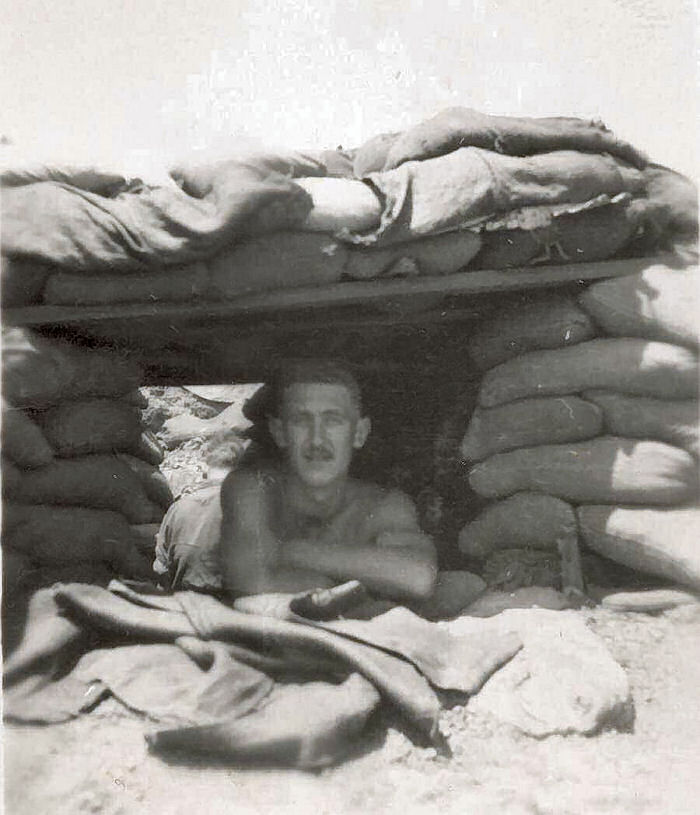 Observation post Little Gibraltar, Hill 355, '53
Observation post Little Gibraltar, Hill 355, '53Big enough to put a shell in, which "Charlie" did.
This is a good example of how not to build an observation pit. Clearlyit would have stood out to the enemy, and surely they would nail it. Inthe case of this ill devised pit, I was sharing it with two others one daylooking for targets of any kind. From out in the distance we heard the POPof a Chinese mortar being fired, shortly thereafter the bomb just clearedthe overhead cover. Exploding in the entrance to a bunker, and on top ofmy gear which was stashed there. The gear caught fire and the bunkerpartially collapsed, trapping several men inside and shocking the heck outof us all. Between we three groggy blokes from the pit, and others whocame to the rescue, the entombed ones were rescued and taken to themedics. They suffered only shock. Fortunately our counter battery ladswere on the job and replied so quickly at the Chinese mortar, they had torun for cover or we would have worn several more with dire results. Thatpit was given the miss for observing from after that. Observation posts came in a multitude of forms, from hiding in a bush to peering out of the view slit, in a very solid bunker. They basically all served the same purpose, to observe the enemy and not be seen in return. The latter case was not always possible, sun shining on your field glasses was a dead giveaway, you being seen by a well hidden enemy, and so forth. Once the war became stabilized in Korea, the enemy went deep underground. They had to in order to avoid our air attacks, and seriously heavy artillery bombardments. This didn't prevent them from using their own artillery and mortars, very skillfully in most cases. A common method was to have those items set back inside a cave or tunnel, then run it out and get away a few quick rounds. When that was done it was back into the cave, out of sight and protected from counter-battery fire. This is where the need for a skillful observer came about, if he could pinpoint just where the fire was coming from, and it could be cross referenced with the bearings taken by another observer, we could locate the hideaway. That in turn could lead to a successful air-strike, or the counter-battery people zeroing in and waiting for the enemy's next appearance outside the cave. Observations were also vital to ensure you didn't have an enemy force digging in, right on your doorstep so to speak. They did this often enough and caught allied forces right off guard, a swift attack from out of nowhere just after dusk, and there they were in our positions. Many a feature was lost in this manner, and many an allied soldier died trying to retake the lost position. Observers at night were a vital cog in the machine, most of this work was carried out by well trained artillery and mortar forward observers. When the enemy opened fire their gun flashes could be seen, and with the aid of several observers' compass bearings it was possible to fix their positions. Then the counter-battery got to work and plastered the area, hoping to catch them still in the open. They must have because annoying mortars and mountain guns often went out of business, following a shower of our air bursts over the top of them. Spotting snipers was another task, our enemy were quite good at laying up until a careless digger showed himself. I must say we never took enough advantage of this tactic, in countering their snipers. It wasn't that we didn't have any, it seems most of them were guarding BHQ or a VIP. My humble opinion was that if they were going to be attacked by guerillas, it wouldn't be from hundreds of yards away, and need skilled snipers to take them out. I may be wrong of course. That was just a sample of the observers and their positions, though unglamorous they performed a very vital task, and at considerable risk. Ron |
|
|